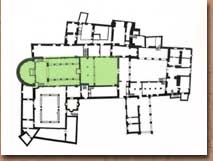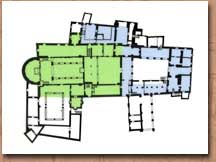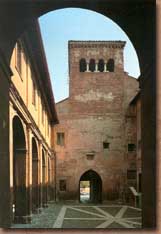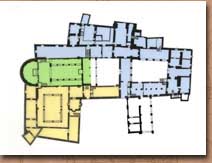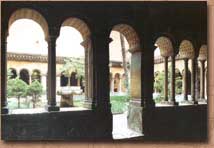Brief history of the monastery complex of Ss. Quattro Coronati in Roma
by Lia Barelli
The original basilica of Ss. Quattro Coronati (four crowned martyrs) was founded towards the end of the sixth century. It stands on the north side of the Coelian hill (Celio) in Rome, and is made up of several buildings grouped around the basilica. The oldest part of the basilica is a large nave with an apse to the west, built on the remains of an elaborate Roman villa dating from late Imperial times. Over the centuries, the group of ecclesiastical buildings that rose around the original basilica acquired considerable importance mainly due to the fact that the site was close to the Lateran Palace, used by the Popes as their official residence throughout the Middle Ages.
In the time of Charlemagne, Pope Leo IV (847-855) made radical changes to the basilica by adding two aisles with three chapels which extend beyond the main walls, and by creating a semicircular crypt beneath the nave. In front of the new basilica, other buildings were laid out around a large central courtyard. Remains of the walls of these buildings can still be seen, incorporated into later constructions. On the east side, there is a portico with arches and pillars which now forms part of the 17th century facade. Behind this was a 22 meter tower which became the basilica's campanile. Alongside the tower were two rectangular halls, and the base of the tower was made up of several arches. On the upper level, three sides of the belfry have a quadruple lancet opening with marble pillars while the fourth side was altered to a triple lancet and pillars, probably in the 13th century. Traces of frescoes show that the tower was decorated inside and outside. Entering by the archway at the base of the tower, one reaches the first courtyard which probably had porticoes around the sides. On the right-hand side of the basilica there is a building, probably also built by Pope Leo IV, which was used as accommodation for the clergy, in particular for the titular cardinal who was responsible for the basilica. The new basilica built by Pope Leo IV was remarkable for its elaborate architecture and its dimensions - 95 metres long and 50 metres wide. The characteristics of the basilica itself were similar to those of the early-Christian models of the Carolingian period, while the other buildings show traces of French and German influence, and as such are unique in Rome.
In 1084, the basilica was sacked by Robert Guiscard's troops and burnt to the ground. It was so severely damaged that Pope Paschal II (1099-1118) had to give up any attempt to rebuild it with the same dimensions. Instead he reduced it to half its previous size by using only the west half of what was left of the main nave. In doing so, he created the two courtyards which form the approach to the present basilica. The first courtyard corresponds more or less to that of the ninth century; the second to the eastern half of the main nave of the Carolingian basilica (remains of some of the arches can be seen on the right as you enter). The aisles of the previous church were incorporated into the new basilica, as were the right-hand side of the cardinal's residence and the left-hand side of the monastery set up by Paschal II himself. In 1138, this latter became a priory for the Benedictine abbey of Santa Croce di Sassovivo near the town of Foligno.
The basilica erected by Paschal II has a main nave with two aisles, divided by two rows of four columns on each side with Corinthian capitals supporting the arches. Two massive rectangular pillars support the end arches as well as the triumphal arch that leads into the transept. Above the nave, there are two galleries overlooking the main nave through two triple lancet openings on each side, with Ionic columns and marble parapets. The apse is still that of the early basilica, partially rebuilt by Pope Leo IV, and this explains its large size with respect to the rest of the interior. The interesting floor, which probably formed part of the early basilica, includes several stone and marble slabs, some with inscriptions on them, taken from an early Christian cemetery in the vicinity. The apse and the transept were decorated with frescoes during the time of Pope Paschal II.
Over the following centuries, the basilica was much altered and further decorations were added. The main nave and the transept were given an elaborate wooden ceiling, completed by 1580, at the behest of the titular cardinal Henry the King of Portugal. Three altars were erected in the aisles and another two at the foot of the pillars supporting the triumphal arch. The left-hand altar has a fine marble ciborium (casket) dating from the time of Pope Innocent VIII (1484-1492). Traces of frescoes, mainly from the 13th and 14th centuries, and some columns from the nave of the early church were brought to light during restoration work in 1913-1914 under the supervision of the Fine Arts Superintendent, Antonio Muñoz.
Access to the semicircular crypt is from the transept. This was created initially by Pope Paschal II who had the steps built. Subsequently in 1623, the titular cardinal Giovanni Garzia Mellini restructured and decorated the shrine where the holy relics were kept. He also had the apse newly decorated by the Tuscan painter Giovanni di San Giovanni. The cylindrical drum was adorned with fluted pilasters of the Corinthian order standing on a high stylobate (base), and the areas between the pilasters, divided into sections with gilded stucco frames, were decorated with frescoes depicting episodes from the lives of the four saints. The fresco on the curved upper part of the apse shows the Glory of All Saints.
The buildings around the basilica underwent major restructuring in the 13th century. In particular, the cardinal's residence was enlarged by cardinal Stefano Conti, a nephew of Pope Innocent III. He built a massive fortified structure on the north side of the basilica, on the ground floor of which is the chapel of St Sylvester that was consecrated in 1247 and contains interesting frescoes depicting the story of Pope Sylvester and the Emperor Constantine. On the upper floor, there is a vast hall, known as the Gothic hall after the pointed arch vaulting with which it is roofed. In recent years, some interesting frescoes, also dating from the mid-13th century, have been uncovered in this hall. At present they are undergoing restoration. When the chapel of St. Sylvester was acquired in 1570 by the Confraternity of the Marmorari (marble workers), whose patrons were the four saints, the presbytery was restructured in its present form with frescoes probably carried out by Raffaellino da Reggio. The members of the confraternity also commissioned the frescoes adjacent to the side entrance of the chapel, beneath the west portico of the first courtyard, showing the Visitation of Mary and the Nativity, dated 1588.
The 13th century monastery was also much enlarged and a cloister in the Cosmati style was added. It is enclosed by the various parts of the monastery which were built at different times. The cloister itself is an architectural jewel in which the Gothic style blends with references to classical art. It has four corridors with arches supported by twin columns whose capitals have smooth leaves. The corridor on the east side leads to the chapel of St Barbara, originally one of the side chapels of the early basilica. It is decorated with marble carvings dating from the ninth century, as well as a series of frescoes painted in the period between the 9th and 13th centuries.
In the 14th century, the cardinal's residence was partly abandoned at the time of the Pope's move to Avignon. When Pope Martin V returned to Rome, Cardinal Alfonso Carillo (1423-1434) carried out major restoration work. But later, when the Papal court was transferred from the Lateran Palace to the Vatican, the building and the basilica declined in importance. In 1564, Pope Pius IV entrusted the basilica and its buildings to the Arch-confraternity of St Mary's Visitation, instructing them to transform it into a monastery and orphanage for Roman girl orphans, run by Augustinian nuns.
During the 16th and 17th centuries, the archconfraternity restructured the whole complex to make it suitable for its new function.However, most of the changes were exterior and today the medieval walls still form the backbone of the structure. An important part of the project was the restoration and modernisation of the two courtyards. In early 1632, two porticoes were constructed on the north and west sides, with cross-shaped pillars surmounted by an upper level. All the buildings overlooking the courtyards were turned into dormitories for the orphans. In the second courtyard, in front of the entrance to the basilica, a deep portico was built probably making use of parts of the early basilica built by Pope Paschal II. Above this portico was the choir hall for the nuns. Throughout the 18th and 19th centuries, the monastery continued to operate as an orphanage, while alterations to the buildings were minimal. In the late 19th century, the orphanage was closed and the complex of buildings was divided into two parts, allocated to different female religious orders. The west part remained in the hands of the Augustinian order, while the east part, after changing hands several times, was eventually entrusted to the Piccole Sorelle dell'Agnello who still retain it today.
Since 1913, thanks to the work of the Fine Arts Superintendent Antonio Muñoz, interest in this monumental complex has increased, and the study and restoration of the medieval parts is still underway today.
|
©
1999 Coordination Monica Morbidelli |
|
Fig. 1 - General plan of the complex with the 4th century hall shaded in green.
Fig. 2 - General plan of the complex with the 9th century structures shaded: the Basilica in green with the two attached chapels of St. Barbara and St. Nicholas in blue.
Fig. 3 - The Carolingian tower as seen from the first courtyard.
Fig. 4 - General plan of the complex with the structures existing in the 13th century shaded: the Basilica in green; the Cardinal's Palace in blue; and the Benedictine monastery with the cloister at its center in yellow.
Fig. 5 - The interior of the Basilica.
Fig. 6 - Detail of frescoes from the Chapel of St. Sylvester: Emperor Constantine, cured of leprosy by his Baptism, places the tiara on Pope Sylvester.
Fig. 7 - The cosmatesque cloister (13th century). |
|
|
|
|
|
|
|
|
|
|
|
|
|
|
|
|
|
|
